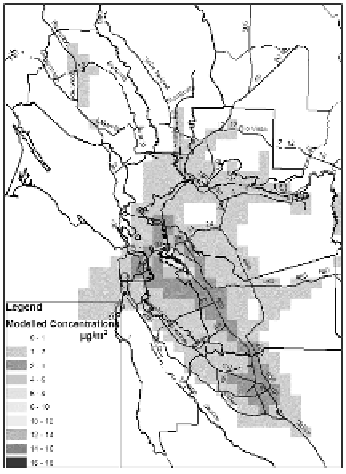Environmental Engineering Reference
In-Depth Information
more than 95% of the region-wide risk-weighted emissions: diesel particulate
matter (diesel PM), 1,3-butadiene, benzene, formaldehyde, and acetaldehyde.
2. Modeling Results and Evaluation
Figure 1
shows simulated annual average diesel PM concentrations, a major con-
tributor to regional cancer risk from air pollutants. Annual average concentrations
of diesel PM were estimated from weighted averages of simulated results from
one summer and one winter month. Annual average concentrations over 6 µg/m
3
were predicted in the Bay Area's urban core; populated areas along freeways had
concentrations in the range of 1-4 µg/m
3
. Diesel PM simulations were found to be
well correlated with elemental carbon (EC) measurements collected via the
IMPROVE method, though differences (not shown) suggest that other sources of
EC are important, particularly in the wintertime.
Fig. 1.
Simulated annual average diesel PM concentrations with county boundaries, air district
boundaries, and major roadways
Annual concentrations and health risk from reactive gaseous toxic contaminants
were estimated from two, week-long (one summer, one winter) reactive chemistry
simulations. Estimated annual concentrations of gaseous toxics were compared to
observations (
Fig. 2)
. Simulated concentrations of benzene, 1,3-butadiene,
formaldehyde, and acetaldehyde were generally smaller than measured values,

